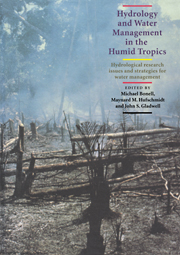 Hydrology and Water Management in the Humid Tropics
Hydrology and Water Management in the Humid Tropics Published online by Cambridge University Press: 23 December 2009
ABSTRACT
A review is presented of the hydrology and water resource values of humid tropical wetlands and lakes. Issues discussed in relation to natural lakes are long-term changes in water levels, aquatic weeds and modelling lake/river interactions. The status of tropical wetland research is presented with reviews of different modelling strategies, empirical water balance studies, and wetland influences upon downstream flows. Current issues involving wetlands in the water resource arena are discussed, and strategies for optimal wetland management and research strategies are identified.
INTRODUCTION
Wetlands occupy approximately 6% of the earth's land surface, and can be found on each of the tropical continents. Table 1 illustrates that tropical wetlands are most extensive in South America, with similar areal extents between Asia and Africa. Balek (1977) reports that the 340 000 km2 of wetlands within Africa are composed of some 104 to 105 individual wetland systems alone. Table 2 illustrates that wetlands can cover up to 10% of individual countries on the African continent and up to 30% on the Asian continent. Early estimates of wetland proportions in the tropics are being revised upwards as improved surveys are carried out in more isolated regions of the world (Maltby, 1988). Furthermore, consideration of wetland extent in the past has tended to under-represent the number of small seasonal wetlands, such as the dambo, pan and black clay types (Howard-Williams & Thompson, 1985), which can occupy over 25% of the land surface areas in many regions of southern Africa.
To save this book to your Kindle, first ensure [email protected] is added to your Approved Personal Document E-mail List under your Personal Document Settings on the Manage Your Content and Devices page of your Amazon account. Then enter the ‘name’ part of your Kindle email address below. Find out more about saving to your Kindle.
Note you can select to save to either the @free.kindle.com or @kindle.com variations. ‘@free.kindle.com’ emails are free but can only be saved to your device when it is connected to wi-fi. ‘@kindle.com’ emails can be delivered even when you are not connected to wi-fi, but note that service fees apply.
Find out more about the Kindle Personal Document Service.
To save content items to your account, please confirm that you agree to abide by our usage policies. If this is the first time you use this feature, you will be asked to authorise Cambridge Core to connect with your account. Find out more about saving content to Dropbox.
To save content items to your account, please confirm that you agree to abide by our usage policies. If this is the first time you use this feature, you will be asked to authorise Cambridge Core to connect with your account. Find out more about saving content to Google Drive.